基于磷去除效果的人工湿地中含活性氧化铝复合基质配比优化
牛 聪,陈浩天,李 鑫,王乐宜,王 勇,张宝莉
基于磷去除效果的人工湿地中含活性氧化铝复合基质配比优化
牛 聪1,陈浩天1,李 鑫1,王乐宜1,王 勇2,张宝莉1※
(1. 中国农业大学资源与环境学院,北京 100193;2. 北京市碧圣联合水务有限公司,北京 102400)
为探究北方寒冷地区人工湿地中含活性氧化铝基质的除磷效果,研究选用活性氧化铝与常用的钢渣、石灰石和沸石作为基质材料,在同等条件下通过等温吸附和吸附动力学试验选择吸附能力最强的活性氧化铝。考虑基质的孔隙度及对水力停留时间的影响,将活性氧化铝与砂和石灰石按不同粒径及不同体积比例混合构建9种组合基质,以生活污水(平均磷质量浓度为2.89 mg/L)为处理对象,模拟单级垂直流人工湿地系统进行小试试验,并选取除磷效果较好的同粒径且含活性氧化铝组合基质以探索其在高质量浓度磷(15.96、38.13和68.22 mg/L)下出水水质达标情况。最后筛选出磷吸附效果最优的含活性氧化铝的组合基质,在多级垂直流人工湿地系统进行中试试验以评价其对污水中高浓度磷(20 mg/L)的去除效果。研究结果表明:1)活性氧化铝对磷的吸附能力最佳,依次为钢渣、石灰石、沸石;2)9种组合基质中75%的活性氧化铝和25%的石灰石组合基质对磷的去除率最高,达93.48%,粒径为3~5 mm且含不同比例活性氧化铝的4种组合基质对磷去除效果较好,将其应用于高浓度磷的污水处理后,出水磷浓度可以达到《北京市水污染物综合排放标准》(DB11/307-2013)中总磷A标准排放限值(0.2 mg/L);3)以75%的活性氧化铝和25%的石灰石构建的组合基质在多级垂直流人工湿地中出水磷浓度均达到A标准排放限值,去除率在94%以上。因此,研究建议以75%的活性氧化铝和25%的石灰石构建组合基质,该含活性氧化铝的基质组合在人工湿地中具有良好的除磷效果和应用价值。
基质;磷;污水;活性氧化铝;去除率;垂直流人工湿地
0 引 言
水中磷含量过高是导致水体富营养化的主要原因之一,有效去除水体中的磷污染物已成为防治水体富营养化的主要途径[1-2]。在污水处理中,人工湿地系统因其处理效果好,建造和运行费用低等优点,尤其在农村地区得到广泛应用[3-7];人工湿地对污染物的去除是利用系统中湿地植物、填料和微生物通过物理、化学及生物的协同作用的结果,对氮、磷的去除效果尤为明显[8-11];基质和植物除磷被认为是除磷最主要的途径。北方地区冬季气温低,植物的枯萎和微生物的活性降低[12-13],基质除磷是人工湿地主要的除磷方式。
人工湿地中基质的沉淀与吸附被认为是重要的除磷机制[14-15],可以去除系统中70%~87%的磷[16-17],而基质的吸附是除磷的关键[18-19]。基质对磷的吸附取决于基质中铝、铁和钙的含量、比表面积、孔隙率、粒度分布和水力传导等物理化学特性[20]。可用于人工湿地的基质众多,大致有人造产品、天然矿物、工业副产物三大类[21-22]。基质对磷的吸附研究表明,可以作为吸附磷的基质有钢渣、生物炭、高岭土、无烟煤、砂砾、大理石和沸石等,其中钢渣的吸附量高[23-24];近年来有研究显示活性氧化铝对含磷废水的去除效果较好,其对水中磷的去除效果优于沸石、陶粒、无烟煤和石英砂等基质[25]。活性氧化铝,是一种单金属氧化物,比表面积大,微孔表面具有强吸附能力[26]。
活性氧化铝对磷的吸附研究中,最大吸附量为0.0738~32.15 mg/g,球状活性氧化铝的固磷量(5.37 mg/g)明显低于粉末状活性氧化铝(16.19 mg/g)[27-30]。这些研究结果表明:不同的试验条件下,得到的吸附量相差很大,可比性低;为了解活性氧化铝与其他的基质对磷的吸附量差异与大小,需要在同等条件下进行吸附特性的对比。活性氧化铝的粒径也是影响吸附量的重要因子,粒径越小其比表面积越大,吸附量也随之增加;而粉状相比球状活性氧化铝,虽然具有很高的吸附量,但在处理污水时,粉状活性氧化铝一旦与水一起排出,会增加污水中铝的含量,且一旦解吸,磷会重新回到水体中;此外,粉状基质在人工湿地中应用困难,它可能与水一起排出或沉积造成人工湿地的堵塞;由此,基质宜选择球状活性氧化铝。
已有的研究中,多是对磷的吸附小试试验,采用下进水、上出水的浸泡的厌氧的装置[27, 31-32],通过控制污水与活性氧化铝接触时间达到去除磷的效果,以及磷的解吸研究[23, 29];还未有对其应用于人工湿地作为基质处理污水的研究。在适用于北方的垂直流人工湿地中,有表面进水下部出水好氧单元,也有厌氧单元;厌氧装置虽然可以控制水体与基质的接触时间,增加吸附量,磷的去除率会增加;但是基质容易达到吸附饱和,为延长基质的寿命,本研究选择把活性氧化铝基质放在好氧的装置中研究其除磷效果,以期达到适当延长基质的饱和时间。在人工湿地的好氧单元中,水力停留时间主要取决于基质的粒径组合,单独的球状活性氧化铝基质可能会造成水力停留时间短,影响吸附效果,由此在基质中加入形状不规则的砂与石灰石进行基质组合以增加水力停留时间,研究其应用于人工湿地基质对污水中磷的去除效果。
1 材料与方法
1.1 基质材料及物理性质的测定
试验选择球状活性氧化铝及常用的钢渣、石灰石和沸石作为基质材料。材料用水进行冲洗,烘干备用。基质孔隙率采用人工湿地先用水饱和、而后放空水量的方法来计算[33]。
1.2 试验设计
1.2.1 不同基质材料对磷的吸附特性试验
将1.1节中4种基质在同等条件下进行对磷的等温吸附和吸附动力学试验,并将这4种基质对磷的吸附能力大小相比较。
1)基质材料的等温吸附试验
在实验室内,称取1 g活性氧化铝、钢渣、石灰石和沸石于50 mL的离心管中,分别加入25 mL浓度为2、5、10、25、50、80、120及200 mg/L的KH2PO4溶液。在转速200 r/min,25 ℃恒温振荡24 h后,于8 000 r/min下离心2 min,测定上清液中磷的含量。
2)基质材料的吸附动力学试验
在实验室内,同样称取1 g各基质于50 mL的离心管中,分别加入25 mL浓度为50 mg/L的KH2PO4溶液,在转速200 r/min,25 ℃条件下恒温振荡,分别振荡30 min、1、2、4、8、12、24和36 h,于8 000 r/min下离心2 min,测定上清液中磷的含量。
1.2.2 不同组合基质对磷的去除效果试验
选取等温吸附和吸附动力学试验中对磷吸附能力最强的基质,同时考虑基质的孔隙度对水力停留时间的影响,并结合常用的人工湿地基质砂子,对基质进行不同比例的组合,考虑到实际工程中的应用,试验设置9种不同粒径及不同体积配比的组合基质,进行污水除磷试验。基质配比处理及其物理性质见表1。
试验模拟单级垂直流人工湿地的水流方式的试验柱进行小试试验,试验柱如图1。试验于2017年4—8月和2018年6—7月进行,地点设在中国农业大学新教实验室和北京市房山区碧圣联合水务有限公司。试验所用污水为厂区工作人员的生活污水,高浓度磷污水为人为在低浓度生活污水中添加KH2PO4。进水由蠕动泵驱动,按照前期工作[1]获得的最佳水力负荷0.3 m3/(m2×d)进水,运行方式为30 min/h(间歇式给水,1 h进水30 min)方式控制,均匀不饱和给水,监测进、出水磷的浓度。
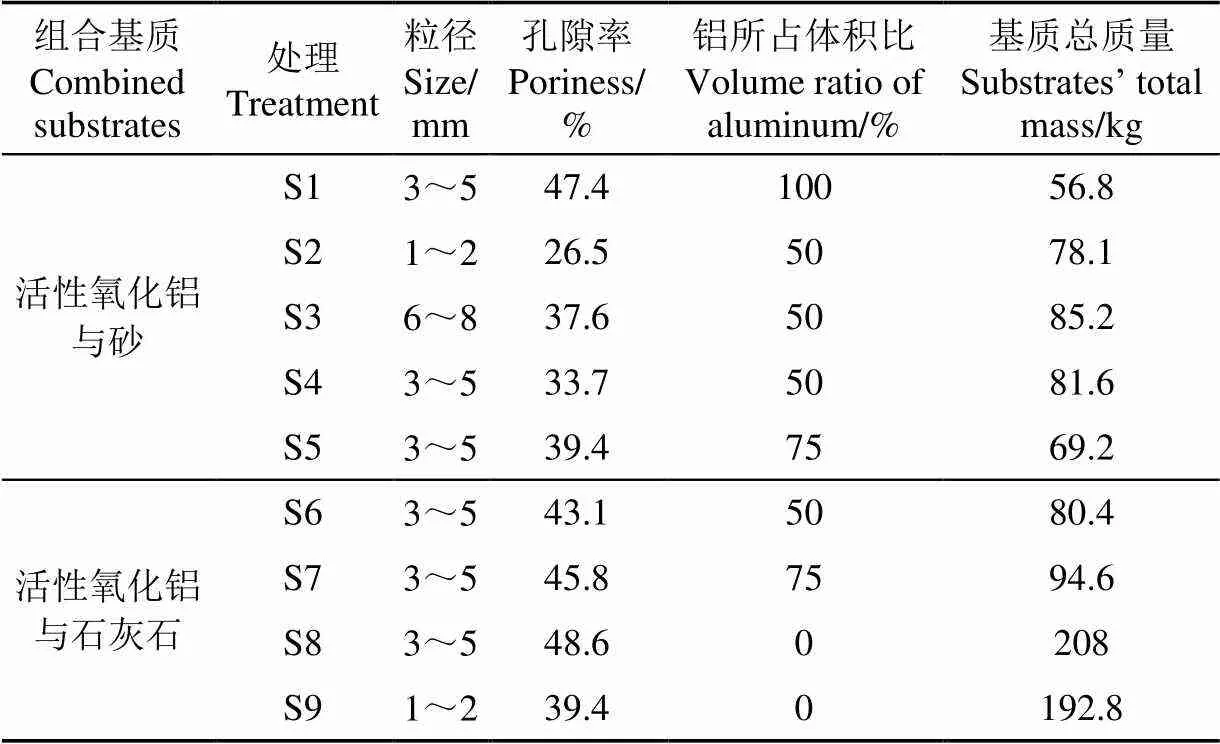
表1 基质配比处理及其物理性质
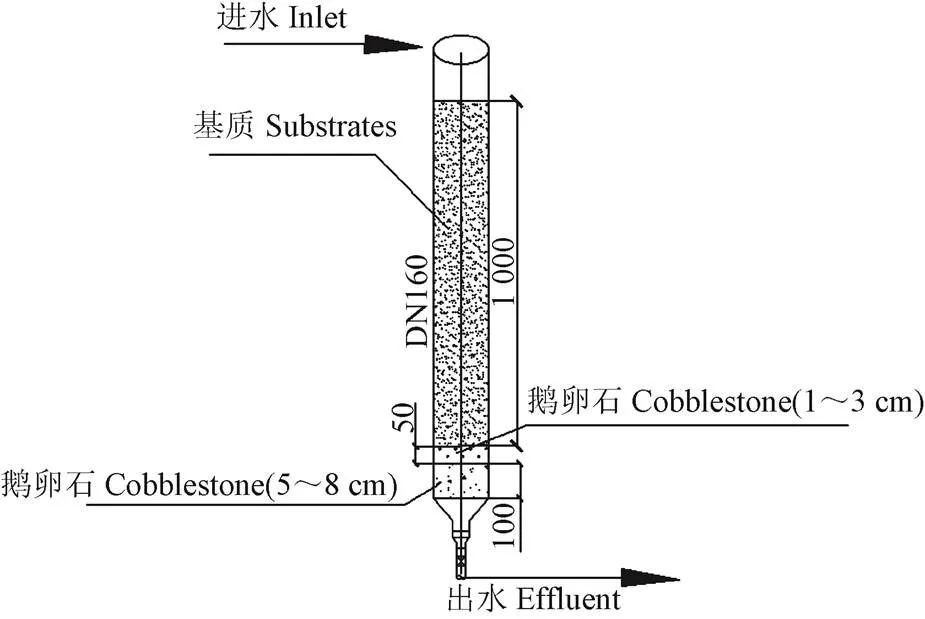
注:图1中数值单位均为mm;DN160为管道型号。
1.2.3 优化组合基质在湿地系统中的除磷效果试验
利用小试试验中除磷效果最优的组合基质,在构建的小型的多级垂直流人工湿地系统进行中试试验,垂直流人工湿地试验装置如图2所示[11]。试验设计长×宽×高为90 cm×70 cm×70 cm的箱体作为湿地处理单元,箱体由不锈钢制成,并做防锈层,箱底装有打孔的PVC隔板,隔板与底层之间有15 cm的集水层,设排水口。进水控制与试验柱相同。前期预运行,使系统内的微生物得到驯化后正式运行。监测进、出水磷浓度。
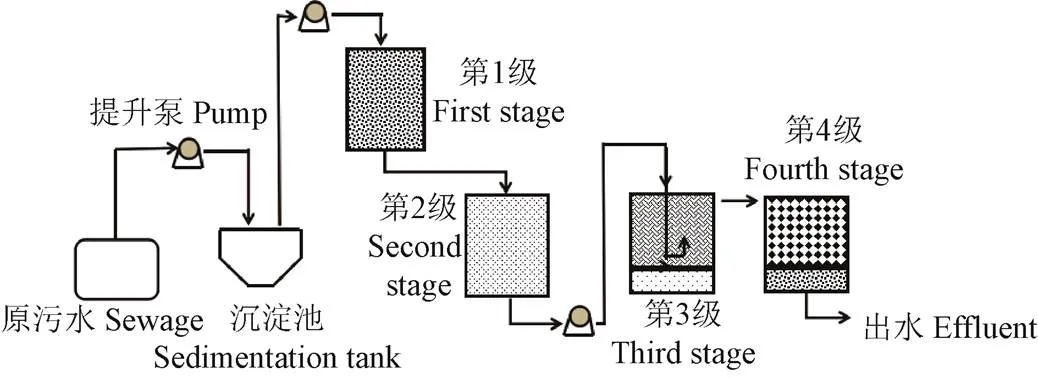
图2 多级垂直流人工湿地系统示意图
1.3 测定指标与方法
总磷(total phosphorus, TP):钼酸铵分光光度法(GB11893-1989)
1.4 数据处理与统计分析
数据和图表采用基于Windows的WPS 2019软件处理分析,利用SPSS 20.0软件进行单因素方差分析,多重比较采用Duncan法,图形采用Origin Pro 9.1软件绘制。
2 结果与分析
2.1 不同基质材料对磷的吸附特性试验
本研究选取1.1节中4种基质材料,在相同的条件下进行磷的等温吸附试验和吸附动力学试验,对比活性氧化铝与另外3种基质对磷的吸附性能。
2.1.1 基质材料对磷的等温吸附特性
4种基质材料对磷的等温吸附曲线如图3所示。
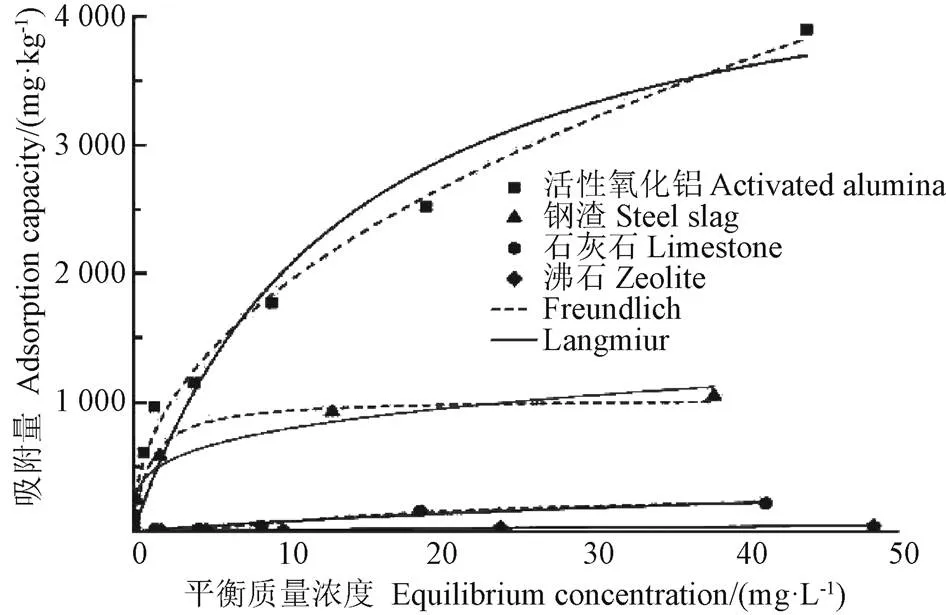
图3 不同基质材料在2种模型下对磷的等温吸附曲线拟合
从图3可以看出各基质对磷的吸附在40 mg/L时基本达到平衡,此时活性氧化铝的吸磷量最高为3.90 mg/g。基质吸附磷的效果依次为活性氧化铝>钢渣>石灰石>沸石。采用等温模型Freundlich和Langmuir对各基质的磷酸盐等温吸附曲线进行拟合后的参数见表2。
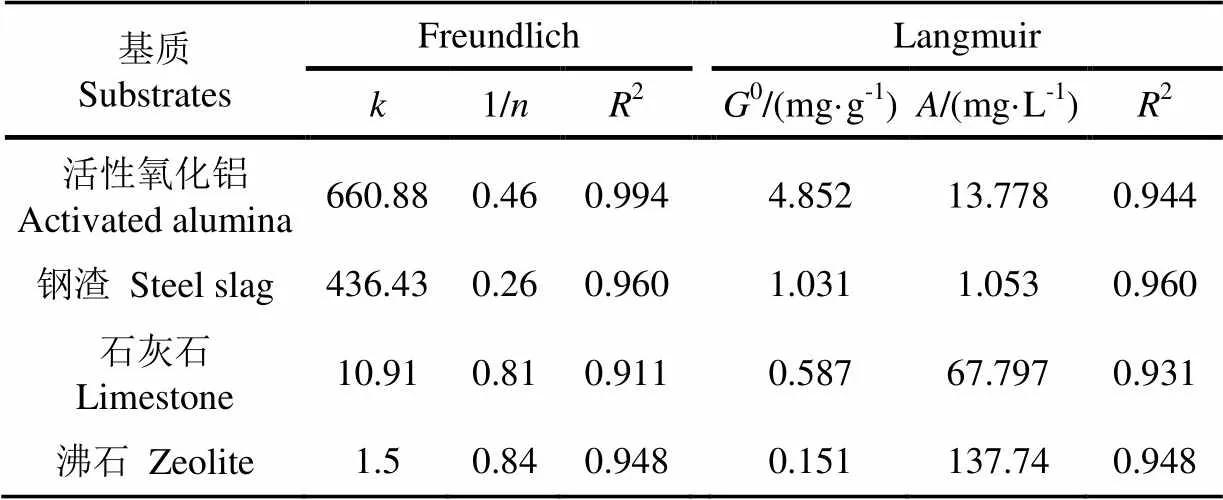
表2 基质对磷的等温吸附模型及其相关参数
注:反映基质磷吸附能力的大小,表示基质的吸附强度0表示磷理论饱和吸附量,表示吸附平衡时吸附质液相浓度。
Note:reflects the phosphorus adsorption capacity of substrates,means adsorption strength of substrates,0means the theoretical saturation adsorption of P,means the liquid phase concentration of adsorbates at adsorption equilibrium.
由表2中可以看出,Freundlich模型与Langmuir模型均能很好地描述试验基质对磷的等温吸附特征,决定系数2均大于0.9。从Langmuir模型结果可以看出活性氧化铝的饱和吸附量最大,为4.852 mg/g,比钢渣、石灰石、沸石分别高出4.71倍、8.27倍、32.13倍。从Freundlich模拟结果中的值可以看出,活性氧化铝的吸附能力强于其他3种基质;从1/可以看出活性氧化铝和钢渣对磷的吸附更容易进行。
2.1.2 基质材料对磷的吸附动力学特性
4种基质材料对磷的吸附动力学曲线模拟见图4。
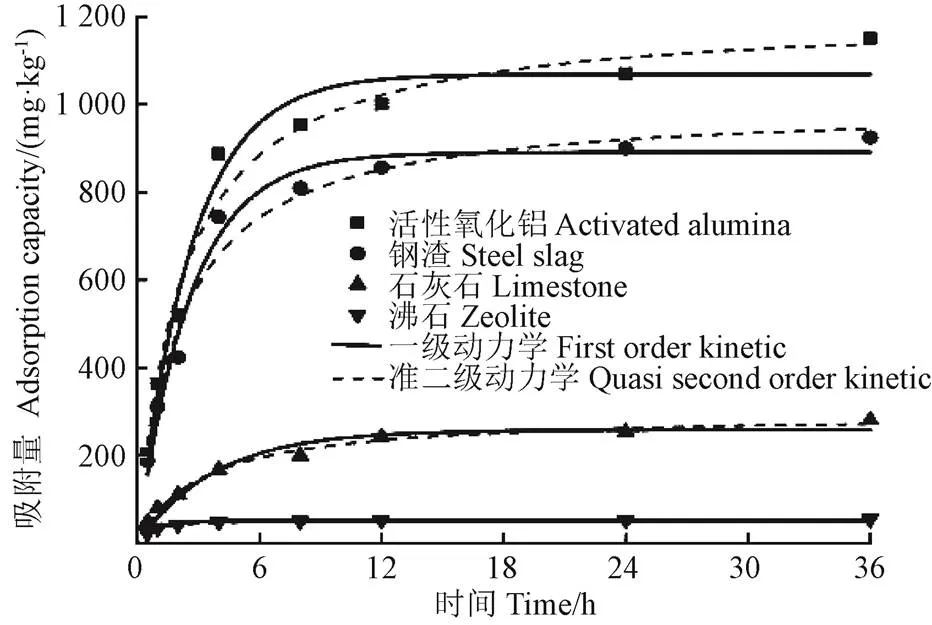
图4 不同基质材料对磷的吸附动力学特征
由图4中可以看出36 h时活性氧化铝的对磷的吸附量最高达到1.15 mg/g,4种基质材料对磷酸盐的吸附效果为活性氧化铝>钢渣>石灰石>沸石。采用一级动力学方程和准二级动力学方程对各基质对磷酸盐吸附动力学曲线进行模拟,试验结果模拟的参数见表3。
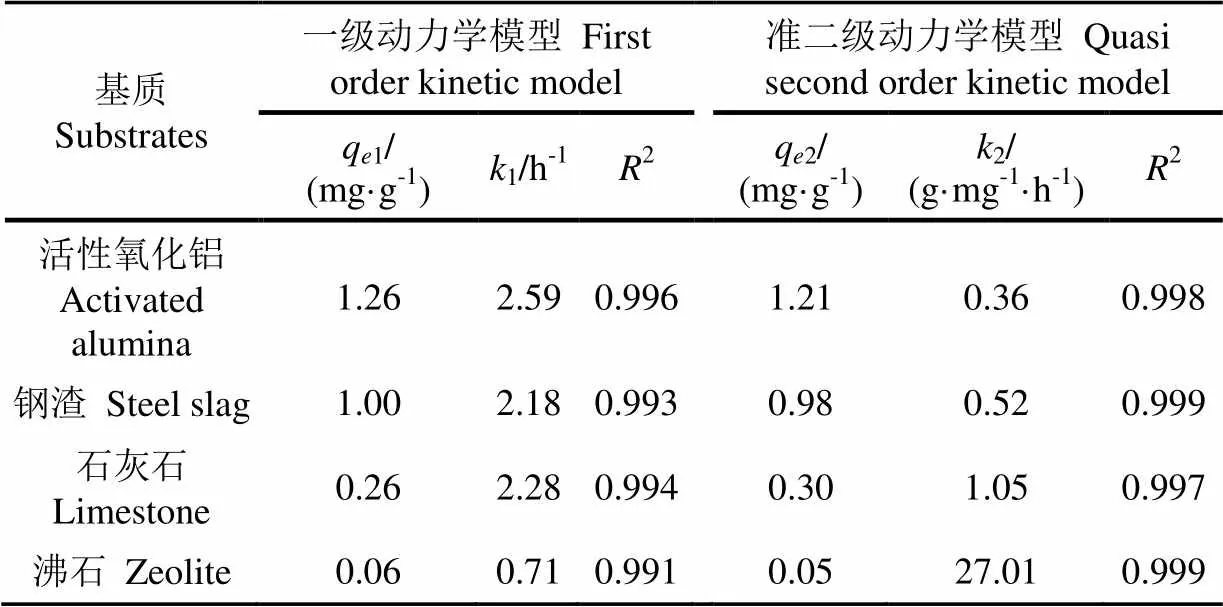
表3 基质材料对磷的吸附动力学参数
注:1和2分别为一级动力学和准二级动力学吸附速率常数,q1和q2分别为一级动力学和准二级动力学平衡时最大吸附量。
Note:1and2are the kinetic adsorption rate constants of first order and quasi second order, respectively;q1andq2are the maximum adsorption at the equilibrium of first order kinetics and quasi second order kinetics, respectively.
由表3中可以看出,一级动力学模型与准二级动力学模型也能很好地描述人工湿地基质对磷的吸附动力学特征,决定系数2均大于0.99,活性氧化铝的吸附速率最快,且活性氧化铝的平衡吸附量(q1、q2)最大,分别达到1.26和1.21 mg/g,其q1比钢渣、石灰石和沸石分别高出1.26倍、4.85倍和21倍,q2分别高出1.23倍、4.03倍和24.2倍。
文献[34]中活性氧化铝的饱和吸附量(0)比本研究高出7.06倍,文献[28]中活性氧化铝的平衡吸附量比本研究分别高出252倍(q1)和3.3倍(q2),说明不同的试验设计取样方法等都会造成平衡吸附量的不同,由此,基质的吸附量只有在同等条件下的试验才具有可比性。
2.2 不同配比的组合基质对磷的去除效果
2.2.1 基质的配比比例及其物理性质
将2.1节中吸附能力最好的活性氧化铝与石灰石及人工湿地砂子进行9种不同的配比的基质混合处理。
基质自身的特性如粒径、孔隙率等直接影响污水处理的效果[35],一般来说,同一类型基质粒径、孔隙度越小,可以使污水在基质中的停留时间增加,污水与基质接触时间长,使吸附作用增加,基质对磷的去除效果增加[11,36]。由表1可知,S8的孔隙度最大,S2最小。不同粒径和不同的组合配置会表现出不同的孔隙度,与基质的粒径不完全相关,这主要是由于活性氧化铝是球状,而其他基质都是不规则的块状,基质之间的接触与形状有关。
2.2.2 不同配比的组合基质对磷的去除效果
将9组不同配比基质填充于单级垂直流人工湿地试验柱中,上端进水,下端出水,探究该9种组合基质对生活污水中磷的去除效果,其中试验用的生活污水总磷质量浓度平均为2.89 mg/L(1.18~4.39 mg/L)。9种不同配比基质对磷的去除率的结果见图5。
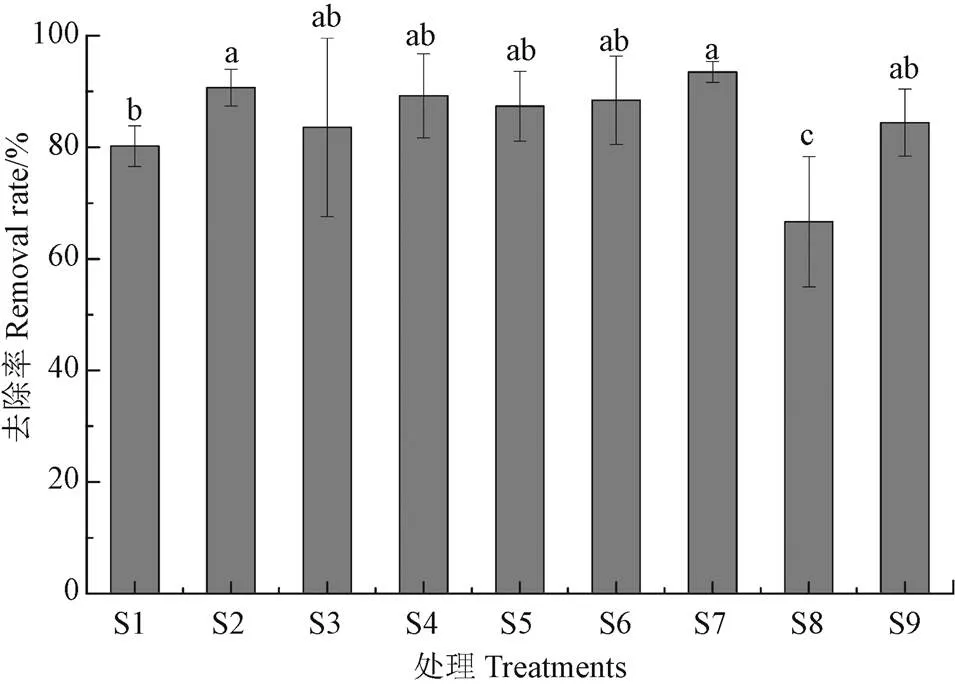
注:不同小写字母代表同一指标具有显著性差异(P<0.05)。
从图5结果可以看出,S8基质对磷的去除率比同为石灰石的S9处理显著降低17.74%(<0.05),可能是因为S8处理的粒径和孔隙度均大于S9,因为粒径及孔隙度越大,会导致水流速度增快,减小了基质与污水的接触时间,会导致对磷的去除效果降低[11, 36]。在相同比例的活性氧化铝与砂的基质组合S2,S3,S4中,孔隙率最大的S3处理去除率为83.54%,S4组合为89.25%,而孔隙率最小的S2去除率为90.70%,但3种处理间并无显著性差异(>0.05),统计发现去除率与孔隙度呈显著负相关关系(=-0.365,<0.01)。除孔隙度外,基质中活性氧化铝含量也对磷的去除效果存在影响,含活性氧化铝的组合基质(S2~S7)对磷的去除效果较好,去除率在83.54%~93.48%之间,统计发现磷去除率与基质中铝的含量呈极显著正相关关系(=0.325,<0.01),这可能是因为增加铝的含量相当于增大了活性氧化铝与磷酸盐的接触面积,有利于吸附除磷的进行[26]。而同粒径(3~5 mm)活性氧化铝分别与砂和石灰石形成的组合(S4~S7)的去除率更高,范围为87.36%~93.48%,平均去除率为89.6%。然而,单一的活性氧化铝基质S1处理对磷的去除率低于活性氧化铝与石灰石的组合基质S7和活性氧化铝与砂石的组合基质S2(<0.05),这可能是由于不同基质的形状不同,其混合后造成孔隙度的改变,进而影响了磷去除率。9种组合基质中S7(活性氧化铝与石灰石)对磷的去除率(93.48%)最高,在含活性氧化铝的组合基质中,S7含活性氧化铝的量最高(75%),与同样比例的活性氧化铝与砂子的组合基质S5高,说明石灰石比砂子对磷的吸附要好。
结果表明,对磷吸附性能好的基质,混合后对污水中的磷的去除效果也好,但是组合基质的除磷效果也与混合后基质的孔隙度相关。基质的粒径越小,组合的基质孔隙度越小,效果也是越好,但是孔隙度小的基质在湿地的运行中,污水中悬浮物的沉淀更容易造成湿地的堵塞而使系统不能运行。由此,合适的粒径选择与基质混合后的孔隙度在湿地的基质设计中起到了很重要的作用。
2.2.3 活性氧化铝的组合基质处理污水中磷的出水效果
农村生活污水中磷的浓度范围是4~15 mg/L,而试验所用污水的磷质量浓度平均仅为2.89 mg/L。为了探究组合基质对高浓度磷的抗冲击及缓和能力,测定组合基质对磷的去除效果及出水水质达标情况,选取2.2.2节中除磷效果较好的4种同粒径含活性氧化铝的组合基质(S4~S7),在污水中加入不同量的KH2PO4,使模拟污水中总磷质量浓度达到15.96、38.13和68.22 mg/L,试验柱同2.2.2节,4种组合基质对磷的去除率见图6。
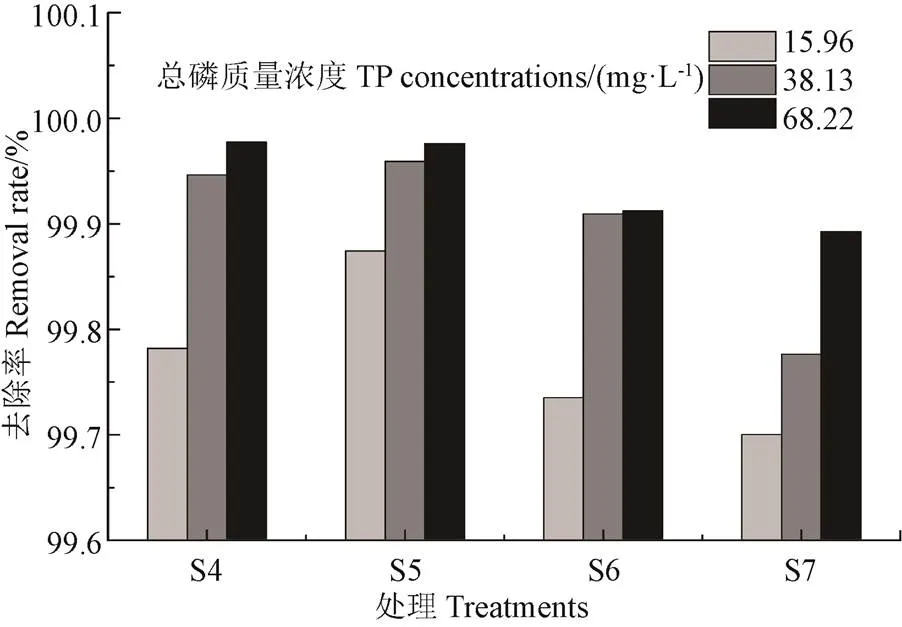
图6 不同初始磷浓度的4种组合基质对磷的去除率
从图6可以看出,随着进水磷浓度的提高,4种基质对磷的去除率有所增加,说明基质对磷的吸附量和磷的初始浓度成正比关系,与一些研究的结果相一致[37-38]。含活性氧化铝的基质对水中磷的抗冲击能力较强,在高浓度磷的条件下,每种组合基质在不同初始磷浓度下对磷的去除率均在99.7%以上,依然可以保持很高的去除率,这也与添加的磷可溶性好有关。本研究的目的是为了满足冬季无植物除磷时,基质除磷的效果要达到出水标准。标准选用《北京市水污染物综合排放标准》(DB11/307—2013)中磷的排放标准,总磷的A标准排放限值为0.2 mg/L,S4~S7的出水磷达标情况如表4所示。

表4 基质的出水总磷浓度达标效果
由表4可知,含活性氧化铝的组合基质的出水总磷都可以达到《北京市水污染物综合排放标准》(DB11/307—2013)中A标准排放限值,在高浓度磷的情况下达到了100%达标率。试验结果表明,对人工湿地基质进行合理配制可以有效地提高人工湿地污水处理效果[39];应用活性氧化铝在人工湿地基质处理生活污水中对磷的去除效果好,尤其是在北方冬季寒冷地区,保证全年总磷达标排放的人工湿地设计中,活性氧化铝作为基质材料具有很高的应用价值和前景。
2.3 活性氧化铝的优化组合基质在多级垂直流人工湿地中应用的效果
应用研究2.2节中得到的除磷最优的组合基质(S7),在不同初始磷浓度下进行多级垂直流人工湿地应用的中试试验,评价该组合基质对污水中高浓度磷(20 mg/L)下的出水水质达标情况及对磷的去除效果。其中在图2的第4级单元填充基质S7,其余第1~3级单元分别填充大石子(直径为5 cm)、砂子和62 kg木块+砂子。
污水采用生活污水,由于原污水的总磷含量较低(3.14 mg/L),人为加入磷使总磷浓度达到20 mg/L(高浓度含磷废水)左右2批总磷浓度的污水进行试验,人工湿地系统出水总磷浓度及磷的去除率如表5所示。

表5 系统进出水总磷浓度及其去除率
由表5可知,S7组合基质对磷的去除率均在94%以上,而相关研究发现[11]应用石灰石作为磷的吸附剂时,其总磷的去除率只有88.0%,出水总磷平均值在0.32 mg/L,波动在《北京市水污染物综合排放标准》(DB11/307—2013)中规定的总磷B标准排放限值(0.3 mg/L)上下,而应用含活性氧化铝基质对高浓度磷进行中试试验后,出水总磷均可以稳定达到A标准。试验结果表明,在应用人工湿地处理农村生活污水中,可以应用活性氧化铝作为基质组合到其他基质中,可以有效地去除污水中的磷,使处理系统出水达到排放标准。
3 结 论
1)Freundlich模型、Langmuir模型和吸附动力学模型均能很好地描述4种基质对磷的等温吸附特征,活性氧化铝材料对磷的吸附能力最强,饱和吸附量G0为4.852 mg/g,平衡吸附量q1和q2分别为1.26和1.21 mg/g。
2)对磷去除效果好的同粒径(3~5 mm)活性氧化铝分别与砂和石灰石形成的组合基质(S4~S7)对磷的去除率在87.36%~93.48%之间,其中基质S7即以75%的活性氧化铝和25%的石灰石构建的组合基质对磷的去除率最高,达到93.48%,且将S4~S7应用于高质量浓度磷(15.96、38.13和68.22 mg/L)的污水处理后,出水磷的浓度可以达到《北京市水污染物综合排放标准》(DB11/307—2013)中总磷A标准排放限值。
3)S7基质在垂直流人工湿地的中试应用试验中,在高质量浓度磷(20 mg/L左右)污水处理中,湿地系统的出水磷的质量浓度均小于0.2 mg/L的A标准排放限值,去除率均达到94%以上。活性氧化铝作为人工湿地基质材料具有很高的应用价值。
[1] O’Neill A, Foy R H , Phillips D H. Phosphorus retention in a constructed wetland system used to treat dairy wastewater[J]. Bioresource Technology, 2011, 102(8): 5024-5031.
[2] Mccomas C, Mckinley D. Reduction of phosphorus and other pollutants from industrial dischargers using pollution prevention[J]. Journal of Cleaner Production, 2008, 16(6): 727-733.
[3] Wu H, Fan J, Zhang J, et al. Decentralized domestic wastewater treatment using intermittently aerated vertical flow constructed wetlands: Impact of influent strengths[J]. Bioresource Technology, 2015, 176: 163-168.
[4] Wu H, Zhang J, Wei R, et al. Nitrogen transformations and balance in constructed wetlands for slightly polluted river water treatment using different macrophytes[J]. Environmental Science and Pollution Research International, 2013, 20(1): 443-451.
[5] Zhang R, Zhou W, Field R, et al. Field test of best management practice pollutantremoval efficiencies in Shenzhen, China[J]. Frontiers of Environmental Science & Engineering, 2009, 3(3): 354-363.
[6] Singh R P, Fu D F, Fu D N, et al. Pollutant removal efficiency of vertical sub-surface upward flow constructed wetlands for highway runoff treatment[J]. Arabian Journal for Science and Engineering, 2014, 39(5): 3571-3578.
[7] 张克强,李军幸,杨莉,等. 复合厌氧折流板反应器-廊道式人工湿地系统运行效果[J]. 农业工程学报,2008,24(6):226-229. Zhang Keqiang, Li Junxing, Yang Li, et al. Operational efficiencies of combined anaerobic baffled reactor and corridor constructed wetland system for domestic wastewater treatment[J]. Transactions of the Chinese Society of Agricultural Engineering (Transactions of the CSAE), 2008, 24(6): 226-229. (in Chinese with English abstract)
[8] 吴树彪,董仁杰,翟旭,等. 组合家庭人工湿地系统处理北方农村生活污水[J]. 农业工程学报,2009,25(11):282-287. Wu Shubiao, Dong Renjie, Zhai Xu. et al. Northern rural domestic sewage treatment by integrated household constructed wetlands[J]. Transactions of the Chinese Society of Agricultural Engineering (Transactions of the CSAE), 2009, 25(11): 282-287. (in Chinese with English abstract)
[9] 王勇,张宝莉,刘灏,等. 人工湿地外加碳源碳溶出及反硝化效果研究[J]. 中国农业大学学报,2017,22(5):137-143. Wang Yong, Zhang Baoli, Liu Hao, et al. Reaserch on the dissolution of extra carbon source and denitrification effect in the constructed wetland[J]. Journal of China Agricultural University, 2017, 22(5): 137-143. (in Chinese with English abstract)
[10] Wu J M, Xu D, He F, et al. Comprehensive evaluation of substrates in vertical-flow constructed wetlands for domestic wastewater treatment[J]. Water Practice and Technology, 2015, 10(3): 625-632.
[11] 王勇,张宝莉,汤灿,等. 寒冷地区多级垂直流人工湿地系统设计及氮磷去除效率[J]. 农业工程学报,2016,32(23):218-225. Wang Yong, Zhang Baoli, Tang Can, et al. Multistage vertical-flow constructed wetlands and removal efficiency of nitrogen and phosphorus in cold area[J]. Transactions of the Chinese Society of Agricultural Engineering (Transactions of the CSAE), 2016, 32(23): 218-225. (in Chinese with English abstract)
[12] 施永海,张根玉,刘建忠,等. 半咸水人工湿地净化越冬养殖循环水的效果[J]. 农业工程学报,2012,28(24):179-187. Shi Yonghai, Zhang Genyu, Liu Jianzhong, et al. Effects of purification of recirculating water in over-winter aquaculture in brackish wastewater constructed wetland[J]. Transactions of the Chinese Society of Agricultural Engineering (Transactions of the CSAE), 2012, 28(24): 179-187. (in Chinese with English abstract)
[13] Liang W, Wu Z B, Cheng S P, et al. Roles of substrate microorganisms and urease activities in wastewater purification in a constructed wetland system[J]. Ecological Engineering, 2003, 21: 191-195.
[14] Mateus D M R, Vaz M M N, Pinho H J O. Fragmented limestone wastes as a constructed wetland substrate for phosphorus removal[J]. Ecological Engineering, 2012, 41(4): 65-69.
[15] Babatunde A O, Zhao Y Q, Burke A M, et al. Characterization of aluminum-based water treatment residual for potential phosphorus removal in engineered wetlands[J]. Environmental Pollution, 2009, 157(10): 2830-2836.
[16] White S A, Cousins M M. Floating treatment wetland aided remediation of nitrogen and phosphorus from simulated stormwater runoff[J]. Ecological Engineering, 2013, 61: 207-215.
[17] Vohla C, Kõiv M, Bavor H J, et al. Filter materials for phosphorus removal from wastewater in treatment wetlands: A review[J]. Ecological Engineering, 2011, 37(1): 70-89.
[18] Dai H, Hu F. Phosphorus adsorption capacity evaluation for the substrates used in constructed wetland systems: A comparative study[J]. Polish Journal of Environmental Studies, 2017, 26(3): 1003-1010.
[19] 贺凯,卢少勇,金相灿,等. 五种填料对磷酸盐的等温吸附-解吸特性[J]. 农业工程学报,2008,24(8):232-235. He Kai, Lu Shaoyong, Jin Xiangcan. et al. Adsorption-desorption characteristics of phosphate by five kinds of substrates[J]. Transactions of the Chinese Society of Agricultural Engineering (Transactions of the CSAE), 2008, 24(8): 232-235. (in Chinese with English abstract)
[20] Blanco I, Molle P, Sáenz de Miera, et al. Basic oxygen furnace steel slag aggregates for phosphorus treatment: Evaluation of its potential use as a substrate in constructed wetlands[J]. Water Research, 2016, 89: 355-365.
[21] Yang Y, Wang Z M, Liu C, et al. Enhanced P, N and C removal from domestic wastewater using constructed wetland employing construction solid waste (CSW) as main substrate[J]. Water Science & Technology, 2012, 66(5): 1022-1028.
[22] Barca C, Troesch Stéphane, Meyer D, et al. Steel slag filters to upgrade phosphorus removal in constructed wetlands: Two years of field experiments[J]. Environmental Science & Technology, 2013, 47(1): 549-556.
[23] 万正芬,张学庆,卢少勇. 19种人工湿地填料对磷吸附解吸效果研究[J]. 水处理技术,2015,41(4):35-39+44. Wan Zhengfen, Zhang Xueqing, Lu Shaoyong. The adsorption and desorption of phosphorus by nineteeen constructed wetland substrates[J]. Technology of Water Treatment, 2015, 41(4): 35-39+44. (in Chinese with English abstract)
[24] Ayaz S Ç, Aktaş Ö, Findik N, et al. Phosphorus removal and effect of adsorbent type in a constructed wetland system[J]. Desalination and Water Treatment, 2012, 37(1/2/3): 152-159.
[25] Wang J L, Zhang Y J, Feng C M, et al. Adsorption capacity for phosphorus comparison among activated alumina, silica sand and anthracite coal[J]. Journal of Water Resource and Protection, 2009, 1(4): 260-264.
[26] 缪佳,郑重,丁春生,等. 氯化铁改性活性氧化铝的制备和表征及其除磷效果研究[J]. 非金属矿,2012,35(3):61-63. Miao Jia, Zheng zhong, Ding Chunsheng, et al. Behavior of phosphorus adsorption from aqueous solutions on modified activated alumina[J]. Non-Metallic Mines, 2012, 35(3): 61-63. (in Chinese with English abstract)
[27] 杨亮亮,王怡. 海绵铁和活性氧化铝滤柱净化城市景观水的对比[J]. 中国给水排水,2017,33(19):11-15. Yang Liangliang, Wang Yi. Purification Effect of sponge iron filter and activated alumina filter on urban landscape water[J]. China Water&Wastewater, 2017, 33(19): 11-15. (in Chinese with English abstract)
[28] 李显波,马力,刘志红,等. 活性氧化铝对废水中磷酸根离子的吸附特性研究[J]. 非金属矿,2017,40(4):4-7. Li Xianbo, Ma Li, Liu Zhihong, et al. Adsorption characteristics of phosphate ion from wastewater onto activated alumina[J]. Non-Metallic Mines, 2017, 40(4): 4-7. (in Chinese with English abstract)
[29] 陈巧,李永梅. 五种物料对磷的吸附—解吸能力研究[J]. 山西农业大学学报:自然科学版,2014,34(1):39-43. Chen Qiao, Li Yongmei. Effect of five materials on the adsorption and desorption of phosphorus[J]. Journal of Shanxi Agricultural University: Natural Science Edition, 2014, 34(1): 39-43. (in Chinese with English abstract)
[30] 孟文娜,谢杰,吴德意,等. 活性氧化铝对水中磷的去除与回收研究[J]. 环境科学,2013,34(1):231-236. Meng Wenna, Xie Jie, Wu Deyi, et al. Study on phosphate removal and recovery by activated alumina[J]. Environmental Science, 2013, 34(1): 231-236. (in Chinese with English abstract)
[31] 常会庆,徐晓峰. 活性氧化铝去除不同浓度污水中磷的研究[J]. 水土保持学报,2013,4(4):181-185. Chang Huiqing, Xu Xiaofeng. Phosphate removal from different wastewater concentration by activate aluminum oxide[J]. Journal of Soil and Water Conservation, 2013, 4(4): 181-185. (in Chinese with English abstract)
[32] 郭佳楠,吴世军,杨永强,等. 活性氧化铝除磷性能及机理研究[J]. 水处理技术,2018,44(1):65-70,75. Guo Jianan, Wu Shijun, Yang Yongqiang, et al. Study on phosphorus removal performance by activated alumina and its mechanism[J]. Technology of Water Treatment, 2018, 44(1): 65-70, 75. (in Chinese with English abstract)
[33] 徐丽. 潜流型人工湿地系统污水处理效果及其基质堵塞问题解决方法的研究[D]. 长沙:湖南农业大学,2014. Xu Li. Studies on Domestic Sewage Treatment Effect and the Solutions of Substrate Clogging of the Subsurface Flow Constructed Wetland[D]. Changsha: Hunan Agricultural University, 2014. (in Chinese with English abstract)
[34] 朱炫,潘杨,黄勇. 钢渣和γ-Al2O3对水溶液中磷的吸附特性比较[J]. 苏州科技大学学报:工程技术版,2014,27(1):10-15. Zhu Xuan, Pan Yang, Huang Yong. Comparison of adsorption characteristics of phosphorus in aqueous solution between steel slag and γ-Al2O3[J]. Journal of Suzhou University of Science and Technology: Engineering and Technology, 2014, 27(1): 10-15. (in Chinese with English abstract)
[35] 赵慧敏,赵剑强. 潜流人工湿地基质堵塞的研究进展[J]. 安全与环境学报,2015,15(1):235-239. Zhao Huimin, Zhao Jianqiang. Research review on clogging in the subsurface flow constructed wetlands[J]. Journal of Safety and Environment, 2015, 15(1): 235-239. (in Chinese with English abstract)
[36] 刘灝. 垂直流人工湿地处理效果及模型模拟研究[D]. 北京:中国农业大学,2015. Liu Hao. The Research on the Treatment Effects of Vertical Constructed Wetland and the Model Simulation[D]. Beijing: China Agricultural University, 2015. (in Chinese with English abstract)
[37] 刘志寅,尤朝阳,肖晓强,等. 人工湿地填料除磷影响因素研究[J]. 水处理技术,2011,37(10):50-54. Liu Zhiyin, You Chaoyang, Xiao Xiaoqiang, et al. Current reaserch on influencing factors of phosphorus removal by substrates in constructed wetlands[J]. Technology of Water Treatment, 2011, 37(10): 50-54. (in Chinese with English abstract)
[38] Kadlec R H, Knight R L. Treatment Wetlands [M]. Bocton: Lewis Publishers, 1996.
[39] 张毓媛,曹晨亮,任丽君,等. 不同基质组合及水力停留时间下垂直流人工湿地的除污效果[J]. 生态环境学报,2016,25(2):292-299. Zhang Yuyuan, Cao Chenliang, Ren Lijun, et al. Research on pollutants removal effect of different combined substrate under different hydraulic retention time in vertical flow constructed wetlands[J]. Ecology and Environmental Sciences, 2016, 25(2): 292-299. (in Chinese with English abstract)
Proportional optimization of composite substrates with activated alumina in constructed wetlands considering phosphorus removal of sewage
Niu Cong1, Chen Haotian1, Li Xin1, Wang Leyi1, Wang Yong2, Zhang Baoli1※
(1.,,100193,; 2..,102400,)
Eeutrophication caused by excessive phosphorus (P) in sewage has attractedincreased attention andcconstructed wetland (CW) is one of common technologies to recover P from sewage, especially in rural areas. The aim of this study is to determine the capacity of different substrates to adsorb P in CW in cold areas in Northern China. We studied four substrates: activated alumina, steel slag, limestone and zeolite;the P adsorption kinetics and adsorption isotherm of each substrate wasmeasured under the same conditions. We then selected the substratesthat had the best adsorption and designed nine mixtures using these substrates with different particle sizes and volumetric ratios. In the design, we took the effect of substrate porosity on hydraulic residence time into account. Small-scale experiments were conductedby mimicking the single-stage, vertical-flow constructed wetland (VFCW) to studyP removalfrom domestic sewage at low P concentration (1.18-4.39 mg/L) using the nine mixtures.Four mixtures with the best P removal were selected to investigate ifthey could meet the effluent quality standard under high P concentration (15.96, 38.13 and 68.22 mg/L), from which the optimal mixture for P removal was foundand we tested its efficiencywhen P concentration was 20 mg/L ina pilot-scale multistage VFCW system. The adsorption isotherm and kinetic experimentwas conducted ina laboratory at China Agricultural University and the small-scale and pilot-scale experiments were conducted at Fangshan district in Beijing, both using the domestic sewage collected from a factory and keeping the designed hydraulic load at 0.3 m3/(m2∙d). The results showed that the P adsorption of all four substrates can be described by the Freundlich and the Langmuir model; the activated alumina had the strongest adsorption capacity, followed by steel slag,limestone and zeolite. Among the nine mixtures used in the vertical-flow test, those containing activated alumina could remove 83.54%-93.48% of P. It was found that amending the mixtures consisting active alumina with particle size in 3-5 mm by sand and limestone could remove 87.36%-93.48% of P, with an average removal rate of 89.63%.Among them, the mixture comprising 75% activated alumina and 25%limestone was most efficient, removing up to 93.48% of P. When P concentration in the sewage increased, the P concentration in the effluent met the Grade A in the Sewage Effluent Discharge Standard (0.2 mg/L) in(DB11/307-2013). The results also showed that the mixing ratio of subtracts could affect P removal rate. Regardless of P concentration in the sewage, the mixture with 75% aluminum and 25% limestone can remove 94%-99% of P in the pilot-scale VFCW test with the P concentration in its effluent being less than 0.2 mg/L, reaching Grade A in the sewage effluent discharge standard.
substrates; phosphorus; sewage; activated alumina; removal rate; vertical-flow constructed wetland
2019-04-26
2019-09-09
国家国际科技合作专项项目“人工湿地在我国北方污水处理中的合作研究”(2011DFG93510)
牛聪,研究方向为污染控制与修复。Email:1060689348@qq.com.
张宝莉,副教授,主要从事污水处理研究。Email:baoli@cau.edu.cn
10.11975/j.issn.1002-6819.2019.17.029
X52
A
1002-6819(2019)-17-0240-08
牛 聪,陈浩天,李 鑫,王乐宜,王 勇,张宝莉. 基于磷去除效果的人工湿地中含活性氧化铝复合基质配比优化[J].农业工程学报,2019,35(17):240-247. doi:10.11975/j.issn.1002-6819.2019.17.029 http://www.tcsae.org
Niu Cong, Chen Haotian, Li Xin, Wang Leyi, Wang Yong, Zhang Baoli. Proportional optimization of composite substrates with activated alumina in constructed wetlands considering phosphorus removal of sewage[J]. Transactions of the Chinese Society of Agricultural Engineering (Transactions of the CSAE), 2019, 35(17): 240-247. (in Chinese with English abstract) doi:10.11975/j.issn.1002-6819.2019.17.029 http://www.tcsae.org

